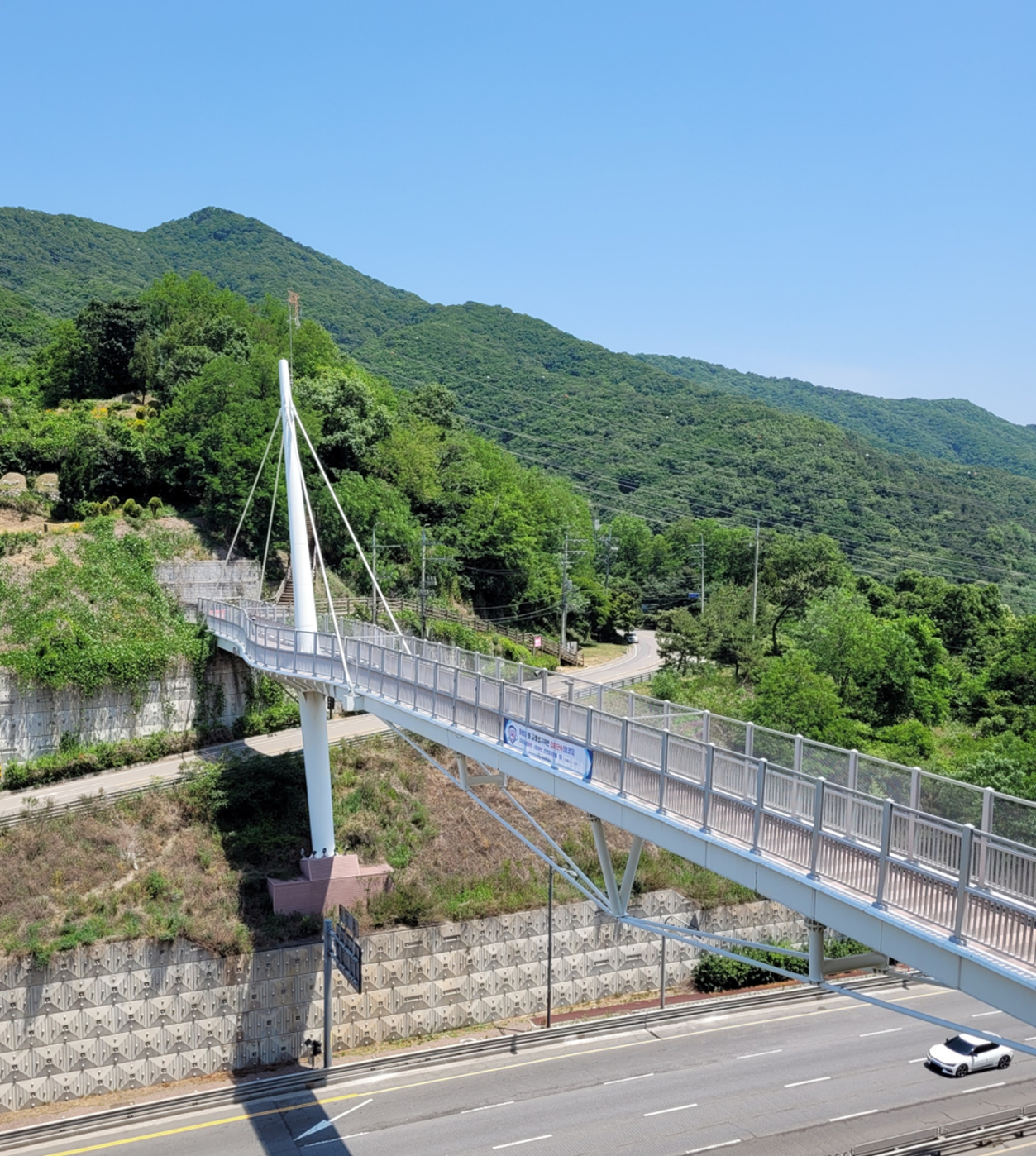1. Introduction
In the field, "traditional support formwork for slab placement" or "precast panels that can be used as an alternative to traditional support formwork for upper slab construction" are used for the installation of upper slabs of bridges.
While precast panels are widely used in the central span between girders for convenient construction and ensuring worker safety, the application of precast panels to the cantilevered sections of the slab is still in the early stages of development and practical implementation.
Cantilevered sections of the slab are not only more complex than the central span but also pose higher construction difficulties. Therefore, the use of traditional formwork known as "magpie's feet" is still prevalent in these areas.
In this context, the author aims to introduce considerations during the design phase, using the most commonly used "traditional support formwork for slab placement" as an example.
2. Main Subject
1) Conposition of Catilever Deck Support

The cantilever formwork support for the slab consists mainly of the main body and the connection part.
The main body is primarily composed of vertical members, horizontal members, and diagonal members, as shown in the illustration. These are either welded or connected by pins. The bottom of the vertical members is equipped with slope-adjustment bolts to adjust the spacing and slope with the girder.
The connection part comes in various forms, but the most common is the J-bolt (also known as ring bolts) in a hook shape attached to the shear connector and a hanger plate (known by various names such as splice plate) linking the formwork body and the J-bolt.
After the concrete is poured for the slab and has cured to a certain strength, the Hanger Plate is cut, and the formwork is dismantled.
Therefore, when designing the formwork support for the cantilever section of the slab, the connection part is crucial as it not only supports the load but also facilitates easy dismantling. Rather than providing excessive flexibility relative to the allowable stress, it is designed to be just sufficient, making it a critical aspect of the overall structural system.
The cantilever formwork support for the slab is installed with a set configuration as described, and it is designed to support the load while adjusting the longitudinal spacing of the formwork.
2) Loads
When designing the formwork support for the slab, the considered loads include the dead load (concrete and formwork weight) and the live load. For typical girder bridges, the thickness of the slab section is 240 mm, and a live load of 2.5 kN/m² is applied for the working load at this height.
In cases where the transverse slope is significant, and the haunch thickness cannot be ignored, the dead load is also calculated, taking the haunch thickness into account.
Additionally, as seen in the diagram below, when there is a working space on the outer side of the slab, the working load in that area must be considered. This is not only a critical audit point but also an essential consideration when applying a working load on the outer side. This is because the maximum section force occurs on the hanger plate when working conditions involve activities on the outer side.
However, it should be noted that depending on the overhang length of the slab and the point where the diagonal member meets the horizontal member, there are cases where the maximum moment on the horizontal member occurs without considering the outer side working load. Therefore, both scenarios need to be considered simultaneously.

3) Support Interval
Typically, shear connectors on girders are spaced at 400 mm intervals in the main section and 200 mm intervals at the ends. The spacing of formwork supports is then determined to match multiples of these connector spacings.
In the main section, it is common to install formwork supports at 800 mm intervals. However, in cases where the cantilever overhang is long, the load may increase, and issues may arise with a 800 mm spacing (N.G. - Not Good). While it would be safer to place them at 400 mm intervals, this would double the number of supports required, leading to strong resistance from companies that would have to bear the cost of additional rent for the supports.
In such situations, it is common at construction sites to install longitudinal reinforcement bars behind the shear connectors and use hanger bolts in that area to provide additional support. However, additional review is necessary regarding the safety of the longitudinal reinforcement in the vertical direction in this configuration.

4) Details of Hanger Plate
The allowable capacity of the hanger plate is determined by the permissible stress multiplied by the cross-sectional area of the hanger plate. It is essential to select and examine the vulnerable cross-section, considering areas where J-bolt deduction sections or cutouts are present.
In some cases, when the thickness is increased in certain products, reinforcement may only be applied to the deducted section of the J-bolt, not the entire hanger plate. Therefore, the designer needs to carefully examine the product's form and select the most conservative cross-section based on the specific situation.
Especially because the hanger plate is designed to be just sufficient, errors in the design of this component can lead to significant accidents.
Furthermore, since J-bolts have a helical shape, the examination should consider the effective cross-sectional area rather than the diameter.


5) The cantilever end
The cantilever end refers to the location where expansion joints are installed. Typically, when the thickness of the general section of the slab is 240 mm, the cantilever end is designed with a thickness of 440 mm.
Since the thickness of the cantilever end is less than twice that of the general section, adjusting the spacing of formwork supports to approximately half the usual interval generally poses no significant issues.
However, a common mistake is designing the cantilever end without considering the spacing of tendons, typically copying the design of the general section. The spacing of tendons is not influenced by the formwork support interval and is subject to concrete loads. Therefore, a separate review is crucial for the spacing of tendons in the cantilever end.
To summarize the considerations during the design process, the following table provides a clear overview:
|
Classify |
Design Precautions
|
|
Load |
If necessary, consider the thickness of the deck haunch Cantilever outside work load (Review each of the conditions of the hanger plate and the maximum cross section force generation in the horizontal Member) |
|
Interval |
Place in multiples of the spacing of the shear connectors, Consideration of safety review of additional long bars when using them |
|
Hanger Plate & J-bolt |
Determined to be conservative cross section when applying cross section width (Apply after checking J-bolt hole deduction or hanger plate cutting part product) Effective cross-sectional use of J-volt (KSB 0233) |
|
Catilever End |
Apply at 1/2 support interval when reviewing the end, but review the joinst interval separately |
6) Structural Analysis
In consideration of the above, the following can be modeled using a structural analysis program such as Midas Civil. (Modeling example)

3. Conclusion
As outlined above, we have introduced considerations for the design of traditional formwork supports widely used in the cantilever sections of bridge upper slabs.
While the structural system of the formwork support for slabs is simple, careful review is essential, especially in the design of connections, as oversight can lead to undesirable outcomes.
In particular, suppliers of formwork supports often do not provide detailed drawings, making it necessary to request the required specifications and verify the materials used during delivery.
When designing formwork supports for slabs, meticulous examination of the mentioned conditions is crucial to prevent accidents such as falling and ensure the highest quality.
Reference
-
KDS 21 50 00 : 2022 (Design Standards for Formwork and Support, Ministry of Land, Infrastructure and Transport in South Korea)
-
KDS 14 30 10 : 2019 (Design Standards for Steel Structural Members (Allowed Stress Design Act), Ministry of Land, Infrastructure and Transport in South Korea)
/%EB%94%94%EC%98%A4%EB%8B%88%EC%86%8C%EC%8A%A4_346_240.png)
Roaming the field,
A civil engineer dreaming of becoming a structural expert
※ Click on the keywords below 'Topics' to view related content.





